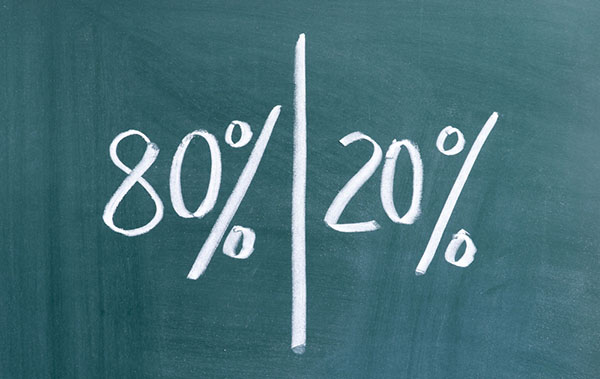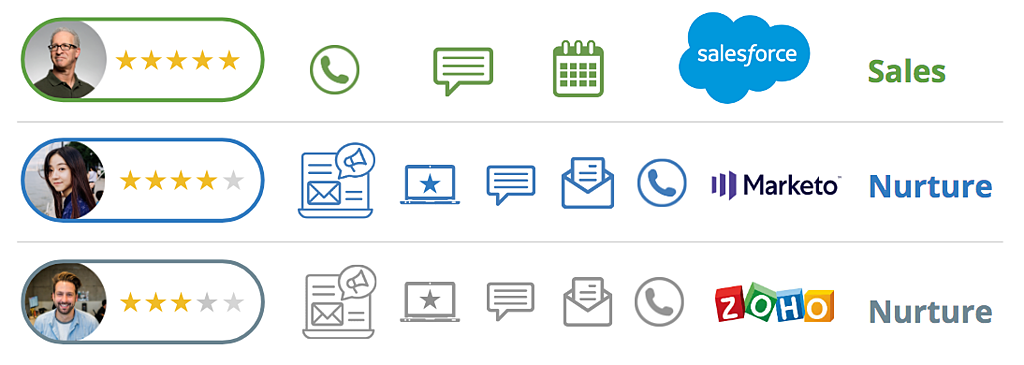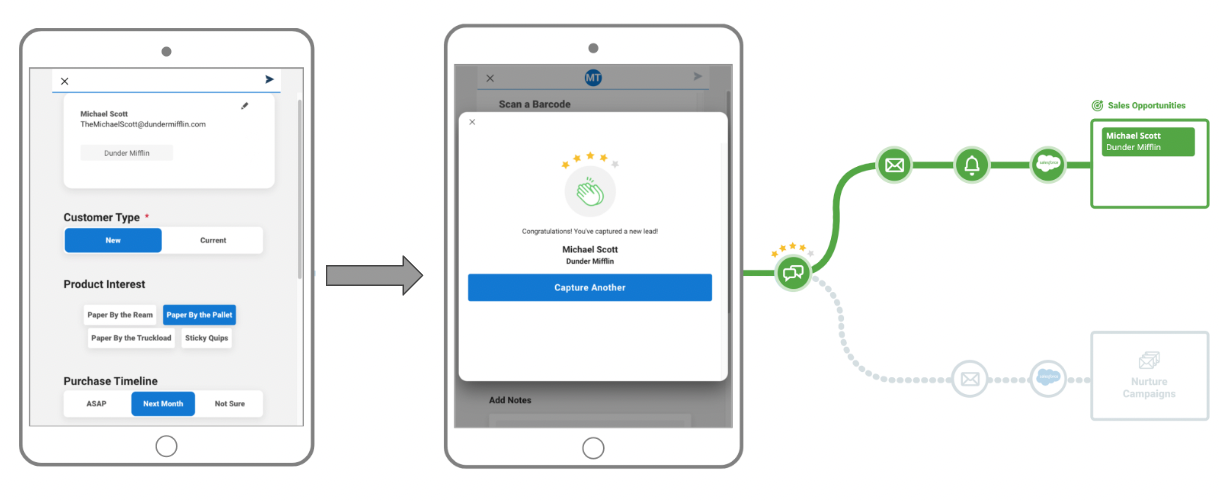You may have heard of the famous 80/20 Rule, or the Pareto Principle. An Italian economist named Vilfredo Pareto developed the concept in 1895 (hence the name). Since then, it has been adapted time after time by modern executives, marketers, salespeople, etc. This concept is important to understand because it can help you identify which initiatives to prioritize so you can make the most impact - including your trade show lead capture.
Understanding the 80/20 Rule:
The Pareto principle states that for many outcomes, roughly 80% of consequences come from 20% of causes. In other words, a small percentage of causes have an outsized effect. While the 80/20 rule applies to almost every industry, the Pareto principle is commonly used in business and economics. This is because the 80/20 rule is helpful in determining where you can focus your efforts to maximize your output.
How the 80/20 Rule Relates to Your Trade Show Lead Capture
The 80/20 Rule also translates to trade show lead capture. 80% of your trade shows ROI comes from 20% of the lead that you capture—your SQLs. The trick is locating that 20% and pushing them to the forefront of your sales efforts.
The Challenges with Traditional Lead Capture Solutions
Traditional lead capture solutions such as badge scanners and business cards make identifying that 20% much more difficult. When you receive an excel sheet of your trade show leads, its pretty difficult, if not impossible to remember which trade show attendees or leads were a part of that top 20%? And with business cards, are you really going to be able to sort them out and keep that 20% separate from the rest? Some trade shows even offer a lead capture tool in the form of an app. While this may seem like a more advanced way to capture leads in theory, your lead data is still just getting put into a spreadsheet. So how do you 80/20 your trade show leads and is there a lead capture tool that can do most of the work for you?
How to Capitalize on the 20%
Since the 20% is so valuable for a positive trade show ROI, you must do all you can to capture leads and capitalize on them. Here are a few lead capture tips to help you get more leads and win that 20%
1. Sort and Prioritize High-Quality Leads
What happens if you skip lead data scoring and put all your trade show leads in one bucket? Well, you end up with zero visibility into what leads matter most. As a result, your sales team treats them all the same: same emails and phone calls, same deliverables, and same generic follow up. Your reps back home also have no idea which trade show leads to follow up with first. So instead they are forced to call leads at random. From our experience, most reps give up after a handful of dud calls. Which leaves those high-value SQLs and potential customers lost
In a mass blur of attendees, how do you target the 20% hot leads? Through lead capture, sorting and prioritization. ON the trade show floor, you want to capture leads and qualify leads as a Sales Qualified Lead (SQL), a Marketing Qualified Lead (MQL), or a Marketing Lead (ML). Then your reps have a clear path ahead to follow up with SQLs. Meanwhile, you can plug MQLs and MLs into different nurture campaigns to generate leads elsewhere. Eventually, some of those leads will convert as well, accounting for the rest of your event revenue.
Lead capture forms are the primary way to qualify leads at a trade show. Your sales reps often will have a set list of questions to ask an attendee, as well as predefined values to determine a lead’s quality. For example, your rep might ask for the prospect’s timeline; an immediate buying timeline would translate to an SQL. Other questions your reps may ask include pain points, job title, product interest, budget, etc.
To learn more about building a lead capture form that will help you have a successful trade show, download our Guide To Building a Winning Trade Show Lead Form.
2. Faster Follow-Up
Did you know that 50% of deals from trade shows go to the first company to follow up? That’s half your deals dependent on one thing: speed. In today’s digital world, prospects lose interest faster than ever. To beat out your competitors, as well as retain prospect interest, you must reengage quickly. Our research has found that the optimal time to follow up is within 48–72 hours of the trade show. If you wait a few weeks, months, or 32 years, the hottest leads will have gone cold—and your trade show ROI will plummet.
By using an intelligent lead capture app that is connected to your CRM, you are able to immediately send your leads to a email marketing campaign and follow-up with your leads in real time, rather than waiting days for a trade show to send you your lead capture spreadsheet.
3.Personalized Follow-up
The final nail in your trade show coffin is using one single, generic email marketing campaign for all your leads. Since your trade show leads are at varying stages of buying, you must meet their expectations. MLs, MQLs, and SQLs all have different understandings of qualified leads, their pain points, needs, and your company itself. You definitely don’t want to send one generic blast across all leads—that won’t touch anyone.
Instead, your email marketing strategy will need to have specific, personalized email campaigns for SQLs, MQLs, and MLs, based on your lead scoring in the trade show booth. By sending a personalized follow-up, you’re telling those leads that you valued the conversation you had in the trade show booth, and you are eager to continue it. It humanizes them and your relationship, rather than them being another email in a spreadsheet. Using multiple email marketing campaigns will—
- Improve your trade show conversion rates
- Educate your leads
- Help prep prospects for sales conversations
- Route more nurtured leads to sales
4. Continuous Improvement Through Data Analysis
Gaining visibility into the success of your trade shows when you use traditional trade show lead capture solutions can be very difficult. A stack of business cards can’t tell you your amount of hot leads or your ROI on a trade show. In order to 80/20 your trade shows, it is extremely important to have that visibility. Who knows, you may be putting 80% into a show, that's only bringing in 5% of your trade show revenue.
With an intelligent lead capture app, you gain visibility into your trade shows and their success. You can see which trade shows were the most successful and which maybe aren't worth getting the big corner booth at. You can also see which products attendees were most interested, which booth reps captured the most leads, etc. Visibility into your trade shows is a huge factor when it comes to the 80/20 rule.
5. Incorporate Account-Based Marketing to Your Trade Show Strategy
Account-based Marketing (ABM) helps to 80/20 your event marketing strategy by focusing on target accounts. Instead of spreading your marketing strategy across all trade show attendees, ABM allows you to focus on the one with the most potential to be come customers. To get started with ABM, it is important to get marketing and sales into the same room. This is when the two teams will get on the same page on what is a target account. Once you have your target accounts identified, you can then start creating your trade show marketing strategy. A couple ways to to use account based marketing at your events is to include those target accounts in your paid strategy and outreach, and drive meetings with those potential leads. Learn more about adding account based marketing to your trade show marketing strategy.
Start Winning With an 80/20 Trade Show Strategy
Like much of the business world, the 80/20 Rule applies to trade shows and events. Because 80% of your trade show revenue comes from 20% of your leads, you want to devote your sales team’s time and energy to the 20%. Applying the 80/20 rule to generating leads, along with an intelligent lead capture app, can be a game-changer for your event ROI. By identifying and prioritizing high-quality leads, qualifying prospects in real-time, personalizing follow-ups, and focusing on the most important leads, you can significantly increase your trade show ROI. Embrace technology and data-driven strategies to make the most of your trade show experiences and drive greater success for your business.
Interested in learning more about intelligent lead scoring and trade show automation? Talk with one of our trade show and lead retrieval experts today.



